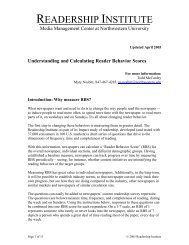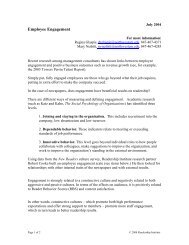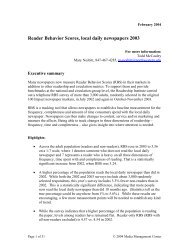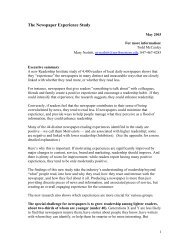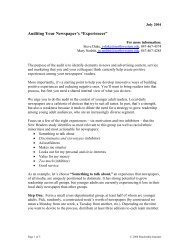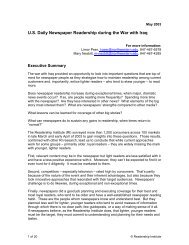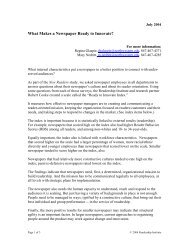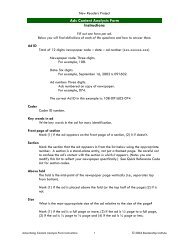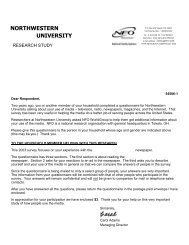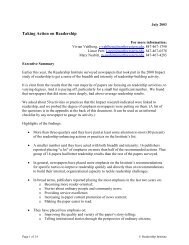Quick Guide to the New Readers culture report - Readership Institute
Quick Guide to the New Readers culture report - Readership Institute
Quick Guide to the New Readers culture report - Readership Institute
Create successful ePaper yourself
Turn your PDF publications into a flip-book with our unique Google optimized e-Paper software.
In any organization, all behaviors are present. What matters is <strong>the</strong> degree <strong>to</strong> which <strong>the</strong>yexist, and how strongly people agree those behaviors are expected.When you look at <strong>the</strong> graphic, identify which styles spike up, and which are at low levels.Ideally, you want <strong>to</strong> have strong constructive styles, weaker aggressive styles and veryweak passive styles.The composite portrait of <strong>New</strong> <strong>Readers</strong> newspapers is aggressive defensive. What thismeans is that people are expected <strong>to</strong> act in ways that protect <strong>the</strong>ir status and security.An especially strong behavior in this <strong>culture</strong> is perfectionism, which means that peopleare expected <strong>to</strong> pay attention <strong>to</strong> detail, never make a mistake and never fail. The upsideof perfectionism is obvious; <strong>the</strong> downside, if perfectionism goes <strong>to</strong>o far, is that <strong>the</strong>organization is slow <strong>to</strong> adapt <strong>to</strong> change; it may focus its perfectionistic efforts on <strong>the</strong>wrong things; and it may strive for <strong>the</strong> unattainable.A second strong behavior is oppositional, where people are expected <strong>to</strong> look for andpoint out mistakes, question everything and strive for objectivity. Again, <strong>the</strong> value of<strong>the</strong>se qualities in some degree is obvious. But if <strong>the</strong>re is <strong>to</strong>o much, <strong>the</strong> organization mayresist change and new ideas for <strong>the</strong> sake of being resistant.Notice that passive defensive behaviors are very much present, <strong>to</strong>o. If aggressive <strong>culture</strong>sare low-risk environments, passive ones are no-risk.Constructive behaviors are least present. Those styles are associated with organizationsthat have a high commitment from and <strong>to</strong> employees, and <strong>to</strong> cus<strong>to</strong>mers. They tend <strong>to</strong> bemore collaborative internally, and in <strong>the</strong> case of newspapers, have higher readership.(For more information on <strong>the</strong> 12 styles, look at pages 9-11 in Tab 3. Pages 19-30 in Tab3 show <strong>the</strong> individual items on <strong>the</strong> questionnaire that relate <strong>to</strong> each style.)Something that cannot be shown graphically on <strong>the</strong> circumplex but is important <strong>to</strong> knowif you are thinking about <strong>culture</strong> change is how intense agreement is among employeesabout <strong>the</strong> kind of behavior that is expected. (See chart on page 14.)Weak agreement indicates <strong>the</strong> behaviors are less firmly embedded, and you will see thisis true for <strong>the</strong> <strong>New</strong> <strong>Readers</strong> newspapers. While <strong>culture</strong> change is never easy (or quick),having weak intensity of agreement especially on <strong>the</strong> defensive styles is an encouragingsign.Pages 31-49 in Tab 3 show <strong>culture</strong> by department, age, race/ethnicity, gender andposition in <strong>the</strong> organization. Overall, <strong>the</strong>re isn’t much difference by race, age or gender.What does make a difference is what department you’re in and where you are in <strong>the</strong>hierarchy.Page 2 of 4© 2004 <strong>Readers</strong>hip <strong>Institute</strong>



